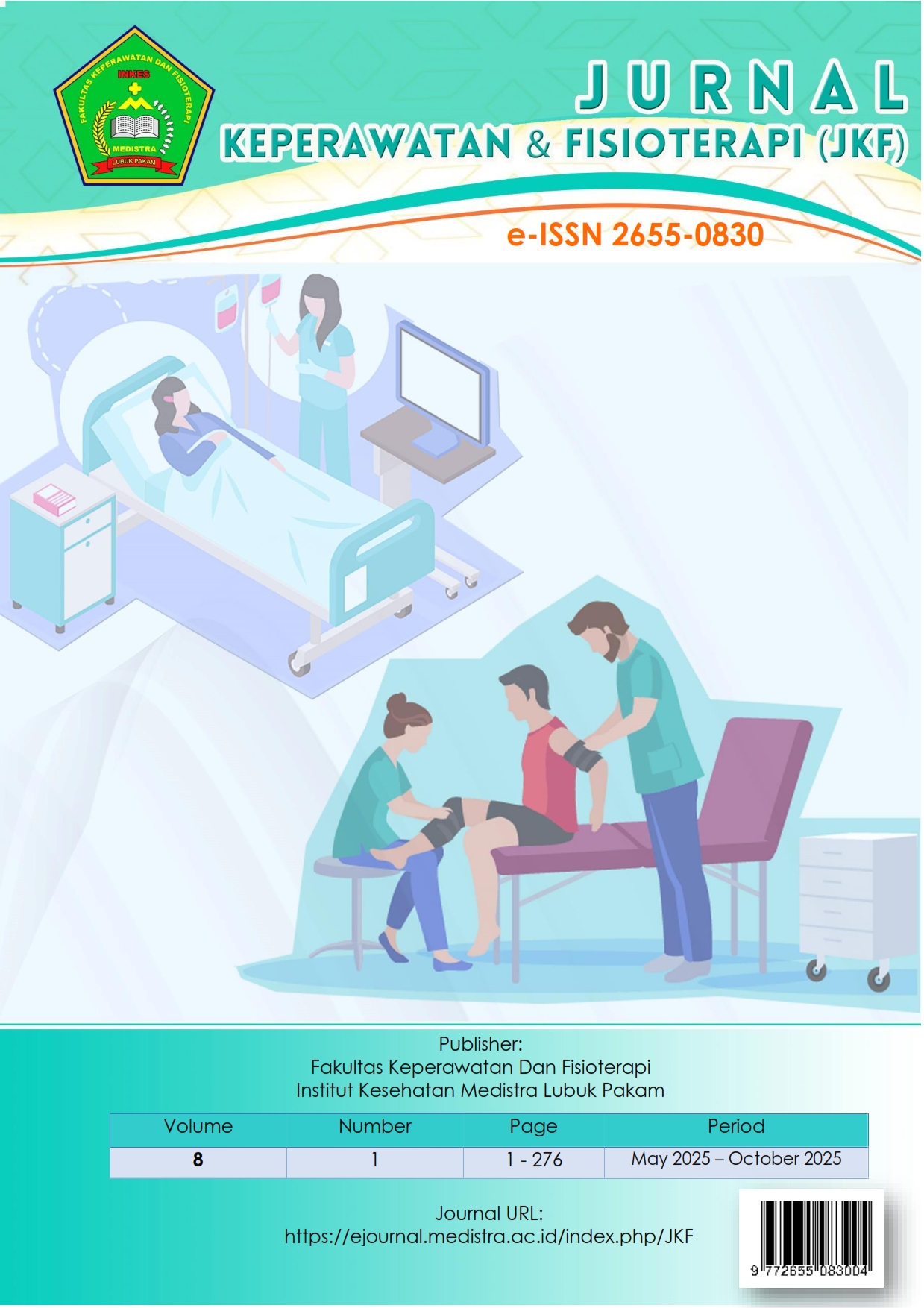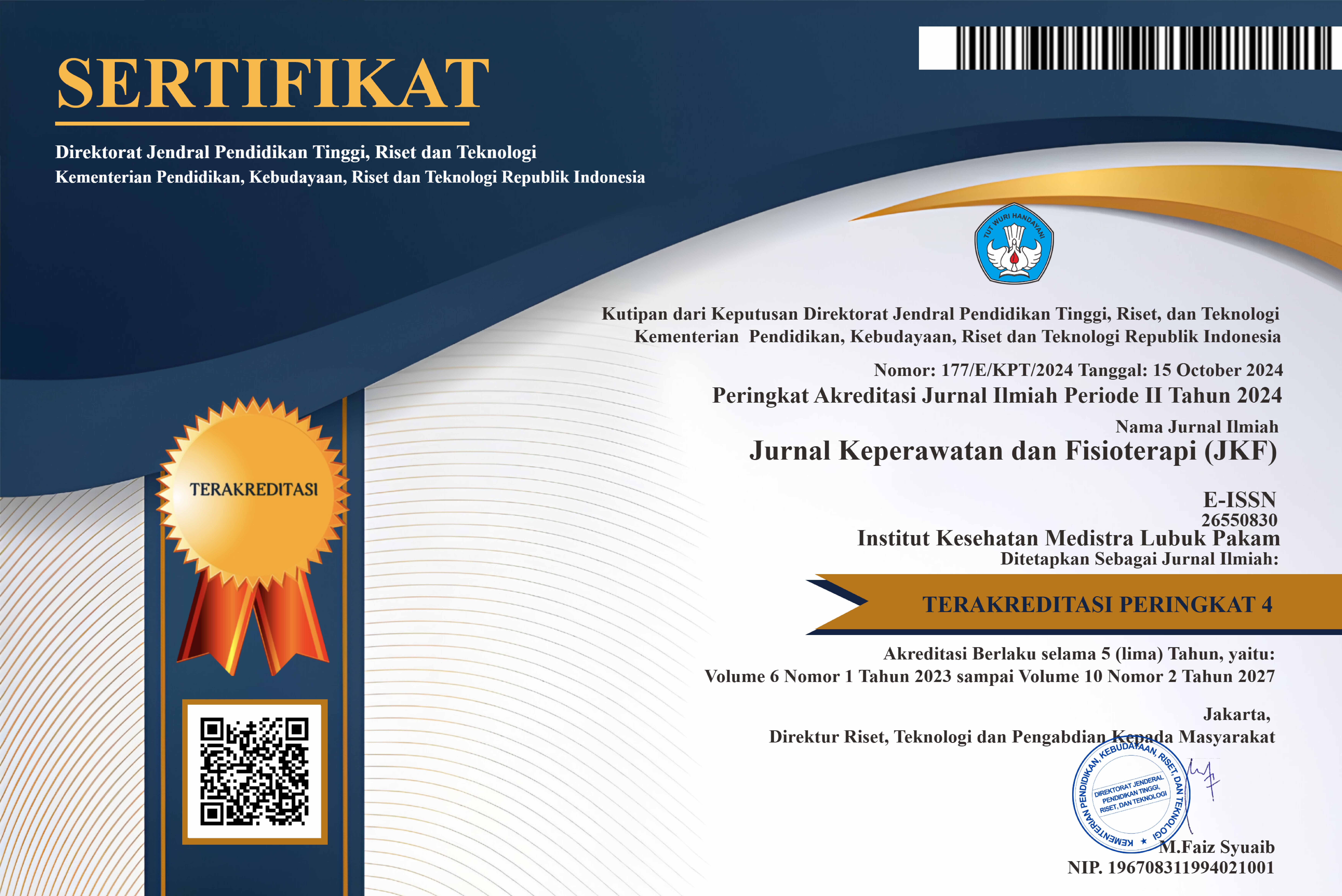The Effect Of Anterior Posterior Glide Mobilization Technique And Hold Relax On Functional Activities In Frozen Shoulder Patients In The Physiotherapy Clinic Grandmed Hospital Lubuk Pakam
DOI:
https://doi.org/10.35451/4hsjty29Keywords:
Anterior Posterior Glide Mobilization dan Hold Relax; Aktivitas FungsionalAbstract
Background: The American Shoulder and Elbow Surgeons defines frozen shoulder as a condition with a specific cause characterized by limited active and passive movement of the shoulder joint due to damage to internal tissues. Physiotherapy modalities that can be applied to this condition include anterior-posterior glide mobilization and hold relax techniques. Objective: This study was to analyze the effect of administering Anterior Posterior Glide Mobilization and Hold Relax on patients with frozen shoulder. Method: Using a quasi-experimental design with two treatment groups and pre-test and post-test measurements, involving 14 respondents. Functional activity assessment was carried out using the SPADI instrument, while data analysis used paired t-test and independent t-test. Results: The study showed a significant difference between the two types of treatment. Conclusion: The administration of Anterior Posterior Glide Mobilization and Hold Relax had a positive effect on increasing functional activity in frozen shoulder patients. Suggestions for future research are expected to involve a larger sample size and a longer intervention duration to obtain more optimal results.
Downloads
References
A, Charles Rockwood.The Shoulder Fourth Edition.China : Saunders; 2016American Academy of Orthopedic Surgeon,2007; Frozen Shoulder ,diakses tanggal 13/10/2014 Availbable from,http://www.otho info.aaos.org/topic.cfm
[2] Christyan.(2015).Functional anatomy, musculoskeletal anatomy, kinesiology, and palpation for manual therapists .Philadelphia: Lippincott Williams & Wilkins.
[3] Cluett. (2014). Frozen Shoulder. Diakses: 12 Oktober 2014. Dari http://orthopedics.about.com/cs/frozen shoulder/a/frozen shoulder.html.
[4] Habermayer, Peter. (2009). Classification And Scores Of The Shoulder. Germany: Springer Berlin.
[5] Kisner, C dan Lynn, A.C. 2007.Therapeutic Exercise 5th Edition. Philadelphia: F.a. Davis Company.
[6] Mound, A Systematic Review And CostEffectivenessAnalysis : Management of Frozen Shoulder. Vol 16; 2012
[7] Mujianto. (2013). Cara Cepat Mengatasi 10 Besar Kasus Muskuloskeletal dalam Praktik Klinik Fisioterapi. Jakarta: CV. Trans Info Media.
[8] Nursalam.(2012). Konsep dan penerapan metodologi penelitian ilmu keperawatan.Jakarta: salemba medika
[9] Notoatmojo,S. (2012). Metodologi Penelitian Kesehatan. Jakarta: RinekaCipta.
[10] Roach K.E., Budiman-Malik E , Songsiridej N, Lertratanakul Y. (1991). Development of a Shoulder Pain And Disability Index. Arthrithis Care Res. 4 (4) : 143-9
[11] Notoatmojo,S. (2013). Metodologi Penelitian Kesehatan. Jakarta: RinekaCipta.
[12] Roach K.E., Budiman-Malik E , Songsiridej N, Lertratanakul Y. (2020). Development of a Shoulder Pain And Disability Index. Arthrithis Care Res. 4 (4) : 143-9
[13] Paulesen, F. & Waschke, J. (2013). Sobota Atlas Anatomi Manusia sendi bahu: Anatomi Umum dan Musculosceletal. Penerjemah : Brahm : U . Penerbit. Jakarta : EGC
[14] S, Lynn. Clinical Kinesiology and Anatomy.Phladelphia : F.A Davis Company ; 2013
Suharto,dkk. 2016 Hold Relax Indonesia Bulletin of Health Research
[15] Surgeons. (2007). Frozen Shoulder. American Academy of Orthopaedic. Diakses tanggal 17 Oktober 2014, dari http://orthoinfo.aaos.org/topic.cfm?topic=a00071.
[16] Troasmoro,s. Ismael, S. (2014) Dasar-dasar metodologi Penelitian Klinis,2nded. Jakarta: Sagung Set
[17] Varcin, L. Unlocking Frozen Shoulder New Paradigm of Treatment.Balboa : 2013
[18] Wahyono, Y., Utomo, B. (2016). Efek Pemberian Latihan Hold Relax dan Penguluran Pasif Otot Quadrisep Terhadap Peningkatan Lingkup Gerak Sendi. Surakarta: Jurnal Ilmu Kesehatan. 5 (1): 1-109.
[19] Z, Viale. Frozen Shoulder Orthophedic EBM.Milan :Sics ; 2014
Downloads
Published
Issue
Section
License
Copyright (c) 2025 Rizka Mutiara, Rabiatun Nasution

This work is licensed under a Creative Commons Attribution 4.0 International License.
Copyright in each article is the property of the Author.


























